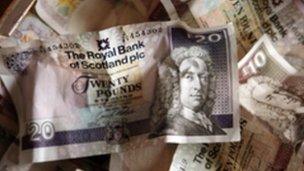Further signs of Scottish recovery
- Published

The PMI study showed Scottish exports were returning to growth
A key indicator of Scotland's economic health has given another strong signal that recovery is under way.
The Purchasing Managers Index, or PMI, shows companies were winning new orders last month.
Managers were also planning to expand recruitment.
It follows positive news last week for much of the UK economy, across services, manufacturing, exports, retail and car sales.
Another study of the economy, by the Scottish government's chief economist, showed productivity had returned to levels seen before the downturn, unlike the UK.
The Scottish PMI, published by Bank of Scotland, showed company managers were seeing strong growth in business activity during July.
Fastest pace
With 50 the point in the index above which there is increasing activity, the Scottish PMI for July registered 56.7.
This was down from 57 for June - the highest point for more than six years.
The UK level for July was slightly ahead of the Scottish one.
While Scottish exports returned to growth, manufacturing saw the second strongest month for expansion in the 15 years since the survey began.
There was also continued growth for service sector companies, winning new work at the fastest pace since 1998.
While price inflation stabilised for inputs to firms, the prices they charge customers rose at the fastest pace for two years.
Backlogs of work in July were up at the fastest pace for more than six years, before the downturn began.
That helps the prospects for employment, which had a positive index for the eighth month. That was particularly strong in manufacturing, although with service recruitment moderating the overall figure was not as strong as in June.
Bank of Scotland economist Donald MacRae said: "Business confidence is clearly on the increase.
"The recovery will become even more embedded if firms build on this ten-month run of positive PMIs by increasing investment."
'Sustained recovery'
Meanwhile, the Scottish government's chief economist, Gary Gillespie, published his quarterly update on the state of the economy.
He said the recovery was gaining momentum and traction, helped by positive news across the UK economy and in the US.
However, he warned of continuing risk from weak growth in the Eurozone, which accounts for more than a third of Scotland's international exports.
He said the problems in Scottish households, which include debt and falling real pay, as well as reforms affecting banks, could also limit the potential for growth.
He said growth remains substantially below the trend levels preceding the downturn.
His report included an analysis of productivity in the Scottish economy, showing it had returned to the level it reached before the downturn began, while UK productivity is below those levels.
Dr Gillespie said that, if this was a permanent rise in Scotland's worker productivity, it could be the basis for stronger growth once demand returns to previous levels, as it suggested there was less slack in the economy than the UK was seeing.
"The recent output growth and underlying nature of the recession in Scotland suggest the potential for Scotland's recovery to gain traction throughout 2013 and the economy as a whole to return to pre-recession levels of output in 2014," the chief economist said.
"This growth will be required to see a sustained recovery in the labour market, particularly employment, and to support improvement in real wages."
- Published5 August 2013
- Published8 July 2013